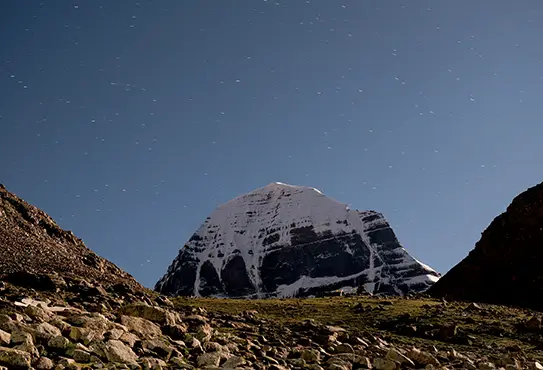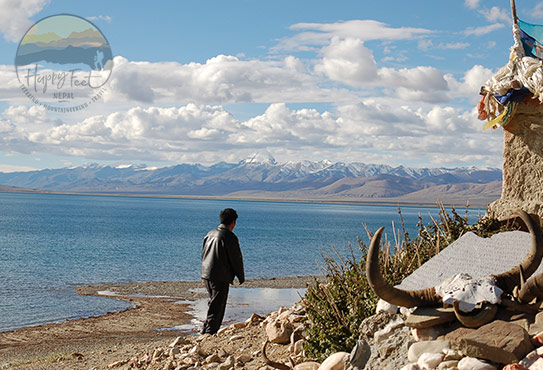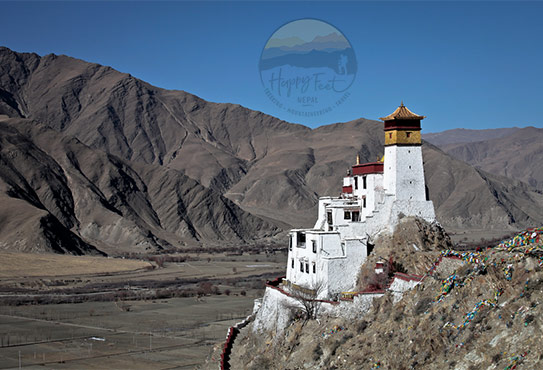-
Sunday - Friday: 9 AM - 4 PM
6-Day Power Places of Tibet Tour
A Journey Through Sacred Lands
Experience the essence of Tibet on a 6-day journey. Start at Gonggar Airport, receive a Khata welcome, and acclimate in Tsedang, the first capital of Tibet, amidst stunning landscapes. Explore ancient Yumbu Lhakhang palace, Tradruk Temple, Kings’ Tombs, and historic Samye Monastery. Hike sacred Hepo Ri, visit Chim-Puk caves, then proceed to Lhasa (“Land of Gods”). Discover Jokhang Temple, Potala Palace, Barkhor circuit, Drepung & Sera Monasteries, and Norbulingka. Delve into profound spirituality and history.
The 6-Day Power Places of Tibet Tour is a concise yet comprehensive journey into the heart of Tibet, starting from Gonggar Airport. Receive a traditional Khata welcome and transfer to Tsedang (3,600m), the first capital of Tibet and the cradle of Tibetan civilisation, nestled on the southern bank of the River Yarlung Tsangpo. This gateway town boasts grazing lands, stunning valleys, snow-capped peaks, glaciers, and a diverse array of flora and fauna. Use your first day in the first capital of Tibet for essential acclimatisation amidst this breathtaking landscape.
Your Journey Through Sacred Lands unfolds as you explore the ancient wonders of Tsedang: Yumbu Lhakhang, the first palace of Tibet, perched on a hill, and the revered 7th-century Tradruk Temple, featuring precious bronze statues and murals. Discover the Tombs of Ancient Kings before driving to the sacred Samye Monastery. The 779 AD Saymey Monastery is the first monastery built in Tibet, housing invaluable statues, murals, and historic bells, each with a rich historical significance that will enlighten you.
Continue delving further into profound spirituality with an early morning hike up sacred Hepo Ri Mountain, a pilgrimage site offering panoramic views and past legends. Visit the holy Chim-Puk caves, where Guru Rinpoche meditated and drive to Lhasa (3,650m), the legendary capital city of Tibet. Lhasa, nicknamed the “Land of Gods,” is the political and spiritual centre of Tibet, awaiting your exploration. These pilgrimage sites are not just places, but sources of inspiration.
In Lhasa, melt into the sacred heritage at the Jokhang Temple, the holiest shrine in Tibet, situated in the bustling Barkhor Square, housing the revered 12-year-old Shakyamuni statue. Visit on foot the majestic 13-story Potala Palace and winter residence of the Dalai Lamas, dominating the Lhasa skyline. Join the clockwise flow of pilgrims circling the Barkhor Street pilgrimage circuit, sense the vast Drepung Monastery, Norbulingka (the summer palace of the Dalai Lamas), and witness the captivating philosophical debates among monks at Sera Monastery. This itinerary offers a deep exploration into soul-stirring landscapes, profound spirituality, and the awe-inspiring history of Tibet.
Transfer to the airport for the flight from Kathmandu to Lhasa on China Southwest Airlines. This one-hour trans-Himalayan flight will allow you to have an aerial view of the Mt. Everest and other Himalayan peaks. We’ll arrive at Gonggar airport at around 1.30 p.m., local time. After clearing immigration and customs you will be received by our Tibetan guide with a traditional Khata, a ceremonial scarf, and drive to Tsetang for 55 kilometres. Arrive and get distributed rooms and free time for rest and acclimatization.
Tsetang is located on the southern bank of the Yarlung Tsangpo River, about 160km south-west of Lhasa at an elevation of 3,600m, and is known for its grazing lands, beautiful river valleys, snow-capped mountains and glaciers. It has a rich variety of flora, distributed vertically according to elevation. Highlights in Tsetang include the first Palace of Tibet, its first monastery, the first Buddhist Hall, and the Tibetan kings’ tombs.
Breakfast and start the tour with Yumbu Lhakhang, the first palace in Tibetan history, built in the 2nd century, on top of a hill. In the palace are the statues of three periods of Buddha. We further continue and visit the Tradruk Temple, a monastery established by King Songtsen Gampo in the 7th-century and belonging to the Gelugpa sect. The ancient images preserved here are made of bronze, and the corridors are full of murals. Finally, visit several Tombs of Ancient Kings; eight or nine tombs are still in good condition.
Lunch and departure to the Samye Monastery, located on the northern shore of the Yarlung Tsangpo River. It is a 206 kilometers drive and takes 4 hours. Reaching Samye you will check into your hotel and free time.
In the evening session, visit the Samye Monastery, considered the first monastery in Tibet, was built in 779 under the supervision of Guru Rinpoche and the Tibetan King Trisong Detsen. The magnificent and unique central hall is three stories high. The first floor is in the Tibetan style, the second in the Han style, and the third in Nepal style. The halls of the monastery contain many statues and murals. The monastery has bronze bells, lions and carved marble tablets that record the development of Buddhism in Tibet. It attracts thousands of visitors each year who come to pay their respects to the Buddha and to learn more about Tibetan Buddhism.
Early morning, before breakfast, hike to Hepo Ri. Hepo Ri is a mountain 400m east of the Samye Monastery, and it requires a 30-minute hike. The locals consider it sacred and a popular pilgrimage site for Buddhists. Many important deities and spiritual beings are believed to reside there, and pilgrimage to the mountain can bring great spiritual benefits. The trail leads from Samye’s East Gate, and a side ridge climbs to an incense burner point with prayer flags, with fantastic views of Samye below. Hepo ri is also said to be where Guru Padmasambhava conquered the demons that disturbed the founding of the Samye Monastery. King Trisong Detsen established a palace here. Hepo Ri is among Tibet’s four sacred hills: ChagpoRi in Lhasa, Gangpo Ri at Tsetang, and Chuwo Ri at Chushul. King Trisong Detsen established a palace here. Trails branch off here from the road leading from Samye’s East Gate. From Hepo Ri, descend south along a paved path and enjoy great views.
Back to the hotel, breakfast and leave for the sacred Chim-Puk tour. Chim-Puk is a sacred cave site where Guru Rinpoche, also known as Padmasambhava, meditated and attained enlightenment. Inside the cave are several small chambers, each containing a statue or a mural of a different Buddhist deity. Visitors to the cave pass dozens of sacred caves and enjoy its serene atmosphere, which makes it an ideal place for meditation and contemplation. The tantric practitioners of Chim-Puk were once famed for protecting fields from hailstorms. Those having an extra day at Samye can reach the summit of Chim-Puk and enjoy a broader view of Yarlung Tsangpo Valley, a whole-day trip.
Back to the Hotel, Late lunch and drive to Lhsa 160 kilometres. Lhasa, the capital of the Tibet Autonomous Region, is located between 290 36’N and 190 06’E at the north bank of Kyichu river, a tributary of the Yarlung Tsangpo river, at an altitude of 3650 meters above the sea level. The Lhasa has a history of more than 1300 years and has been the centre of politics, economy, culture, and religion in Tibet since ancient times. “Lhasa” in Tibetan means “the land of Gods”. In Lhasa, there is a plentiful of scenic spots and historical attractions, among which Potala Palace, a thirteen-story, 1000 room Palace of the Dalai Lama, Norbulingka, the summer Palace of the Dalai Lama, Drepung Monastery, Sera Monastery, Jokhang Temple, the holiest shrine of Tibet, and the famous Ramoche temple.
Breakfast and pay a visit to the Jokhang Temple, situated in the centre of the old section of Lhasa called Barkhor, was built in the mid-7thcentury AD. It was extended later by successive rulers and has now become a gigantic architecture complex. Located in the east, and facing the west, Jokhang is a four-storeyed temple with splendid golden roofs. Its architecture features art from the Tang Dynasty but also assimilated many features from both Nepalese and Indian Buddhist temples. The murals in the temple depict the life stories of historical and religious characters. The temple houses many ancient relics, including statues of King Shrongtsen Gompo, Princess Wencheng, Princess Brikuti Devi (Nepalese). Princess willow (a tree), and the uncle–Nephew Alliance Tablet. Jokhang is Tibet’s spiritual centre and the holiest destination for Tibetan Buddhist pilgrims. It contained a sitting statue of Shakyamuni when he was 12 years old.
We then continue to Potala Palace, one of the most famous architectural works of the Tibetan World, which sits on top of the red hills in Lhasa. It was built in the 7th century after the Tibetan King Shrongtsen Gampo married Princess Wencheng of the Tang court. The Palace was built to provide a court with a place of worship and meditation. In the mid 17th century, it was rebuilt by the 5th Dalai Lama to its present size and became the winter Palace of the Dalai Lamas. The construction took fifty years from beginning to completion.
The Potala Palace is divided into two sections, namely, the red Palace and White Palace. The total height of the Potala is 117 meters spanning thirteen stories. The length of the Palace from east to west is 400 meters, and the breadth from south to north is 350 meters. The building was constructed with stone and timber with golden roofs. It is a majestic architectural masterpiece.
In the evening we visit Barkhor Street, the holiest pilgrimage site in Lhasa, with innumerable shops, and wayside peddlers intermingle with devotees walking clockwise around the Jokhang. There are four huge prayer flags in each corner of Bhakor square, known respectively as Gadhen Dharchen in the northeast, Juyak Dharchen in the west, Kelsang Dharchen in the southwest and Shar Kyaring Dharchen in the southeast. An evening walk (Kora) around the Jokhang Temple, together with the Tibetan pilgrims is a lifetime experience.
Today we will visit the Drepung Monastery, situated on the slope of Wuze Hill, five kilometres northwest of Lhasa. It was built in 1416 and is the largest of the monasteries of the Gelugpa sect. It covers an area of 250,000 square meters. In its heyday, it had more than 10,000 monks.
Finalize the visit to the Drepung and proceed to the Norbulingka, the summer palace of the Dalai Lama and currently a museum.
At around 14:00 hours visit the Sera Monastery located about 3km north of Lhasa and at the foot of Tatipu Hill. Sera is one of the most important monasteries and sacred to the Gelugpa sect, founded by Tsong Khapa or yellow hat sect, a branch of Tibetan Buddhism, in 1419, once had 7,000 monks. It has several buildings, the main ones being the Salón Coquen and the specialized schools. Inside the monastery there are preserved sacred scriptures written with gold dust, murals and unique statues, with main statue of Hayagriva, the Horse-headed (protector of the Dharma). This monastery is famous for the monk’s debate for a few hours each afternoon. There is a question-and-answer session during this ritual where a senior monk asks a junior with grimaces, applause, and feigned threats. The important part of this ritual must go through the knowledge of the theosophical questions of the Tibetan lamaistic Buddhist. A very curious moment for the tourist.
Breakfast and drive to Gonggar airport or train station for onward destinations.


